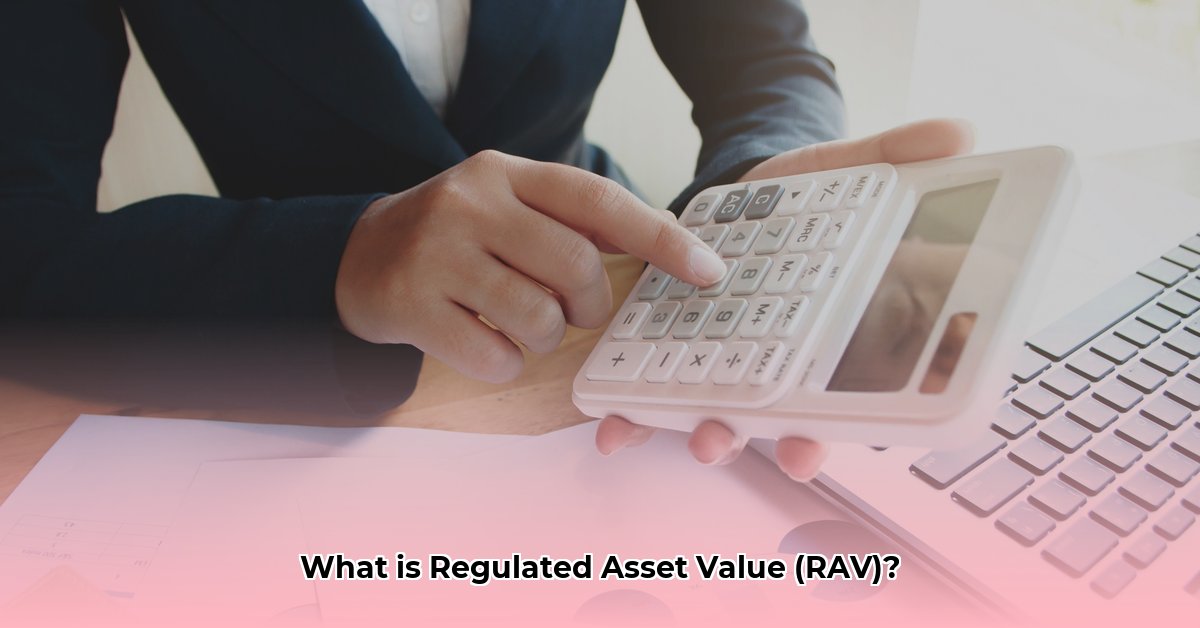What is Regulated Asset Value (RAB)?
Regulated Asset Value (RAB) is the value assigned to a utility company’s fixed assets—like power plants, pipelines, and transmission networks—used to determine the prices they can charge consumers. This value, set by regulators, aims to reflect the current cost of replacing those assets, not their original cost or market value. This ensures utilities can invest in maintaining and upgrading these critical systems while providing essential services at a reasonable price.
Calculating RAB: A Step-by-Step Approach
While specific calculations vary by region and industry, the core principle involves assessing the present-day worth of assets integral to service delivery. This often begins with the initial capital expenditure, subsequently adjusted for depreciation, improvements, and inflation. A regulatory body reviews this valuation, approving a reasonable rate of return for the company. This approved rate, applied to the RAB, determines the revenue recoverable from consumers.
Step 1: Initial Value (Historical Cost): The starting point is the original cost of assets when first put into service.
Step 2: Capital Expenditures: Add any investments made to upgrade or expand infrastructure.
Step 3: Depreciation: Subtract the decrease in asset value due to wear and tear. Various depreciation methods exist, and the chosen method can significantly influence the final RAB. Ongoing research suggests some methods may more accurately reflect real-world asset decline.
Step 4: Inflation Adjustments: Adjust the RAB to account for inflation. Different regulatory bodies utilize various indices and methods, an area where research suggests potential improvements.
Step 5: Other Adjustments: Incorporate any other adjustments based on specific regulations or unique circumstances, such as grants for infrastructure projects or adjustments for environmental compliance.
RAB Formula: RAB = Initial Value + Capital Expenditures – Depreciation + Inflation Adjustments + Other Adjustments
RAB vs. NBV vs. Market Value
Understanding how RAB differs from other valuation methods provides essential context.
| Metric | Description | Example (Hypothetical Power Plant) |
|---|---|---|
| RAB | Value of regulated assets determined by a regulatory authority. | $10 billion |
| Net Book Value (NBV) | Original cost of assets minus accumulated depreciation. | $8 billion |
| Market Value | The potential selling price of assets in the current market. | Fluctuating; potentially $12 billion or more |
RAB offers stability compared to fluctuating market values and incorporates regulatory considerations, unlike the purely accounting-based NBV. Unlike market value, which reflects what someone might pay, RAB aims to represent the cost of providing the same service today.
RAB’s Impact on Utility Prices
RAB directly influences consumer utility bills through the cost-of-service regulation model. A simplified version of this formula is: Revenue Requirement = Operating Costs + Depreciation + Taxes + (RAB * Rate of Return). A larger RAB generally leads to a higher revenue requirement and, likely, higher consumer rates. Conversely, a smaller RAB can result in lower rates.
Regulators scrutinize proposed additions to the RAB, disallowing unnecessary or excessive costs. This prevents utilities from passing on inflated expenses to consumers. However, “regulatory assets,” such as environmental cleanup costs or energy-efficiency investments, are included in the RAB and recovered from customers over time.
The valuation method for assets within the RAB also matters. Some regulators use the original cost, while others use fair value, which can significantly affect consumer rates. Additionally, the regulatory environment, including tax laws and allowed rates of return, further influences RAB and utility prices.
Real-World Implications and Future Trends
RAB impacts investors, consumers, and utility companies. Investors use it to assess financial health, regulators use it to protect consumers, and utility companies use it for financial planning. The increasing use of renewable energy and fluctuations in interest rates will probably impact future RAB calculations. Ongoing research into inflation accounting and depreciation models may lead to refinements in how RAB is calculated, potentially impacting consumer costs and investment decisions.
Advantages and Disadvantages of RAB
Advantages:
- Attracts long-term investment by offering predictable returns.
- Provides stability for investors, shielding them from market volatility.
- May result in lower overall project costs due to upfront funding.
Disadvantages:
- May expose consumers to project risk by requiring contributions before operationalization.
- Requires effective regulatory oversight.
- Can lead to higher upfront consumer costs.
Comparing RAB with Contracts for Difference (CfDs)
Both RAB and CfDs encourage infrastructure investment but employ different cost recovery mechanisms. RAB involves ongoing consumer contributions throughout a project’s lifecycle, while CfDs primarily activate post-operationalization. The choice between the two models depends on the specific project context and the balance between upfront and long-term costs.
Frequently Asked Questions (FAQ)
-
How is RAB different from market value? RAB focuses on the cost of replacing existing assets, while market value reflects the price the assets would command in the current market.
-
Who determines RAB? Regulatory bodies oversee and approve RAB calculations.
-
How does RAB affect me as a consumer? RAB influences the rates you pay for utility services. A higher RAB often leads to higher rates.
-
What are regulatory assets? These represent costs included in the RAB that benefit consumers, such as investments in environmental cleanup or energy efficiency.
Glossary of Terms
- Regulated Asset Value (RAB): The value assigned to a utility company’s fixed assets for rate-setting purposes.
- Net Book Value (NBV): The original cost of assets minus accumulated depreciation.
- Market Value: The price at which an asset could be bought or sold in the current market.
- Depreciation: The decrease in an asset’s value due to wear and tear.
- Capital Expenditure: Funds used by a company to acquire, upgrade, and maintain physical assets.
- Weighted Average Cost of Capital (WACC): The average rate a company expects to pay to finance its assets.
This comprehensive guide offers insights into RAB, its calculation, its impact, and its future. Ongoing discussions and research suggest that the regulatory landscape and associated methodologies will continue to evolve, emphasizing the importance of staying informed about developments in this field.
- Water Wheel Electric Generator Provides Free Home Electricity - December 15, 2025
- Choosing the Right Portable Hydro Turbine for Your Needs - December 14, 2025
- Best Portable Hydro Generators for Off-Grid and Outdoor Power - December 13, 2025
















